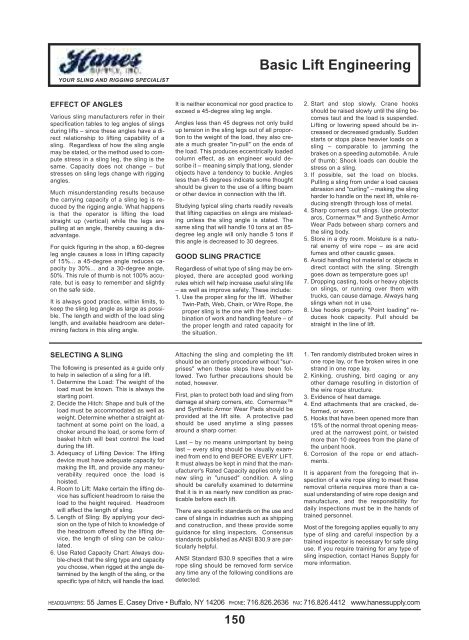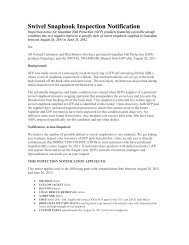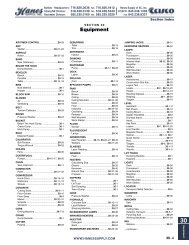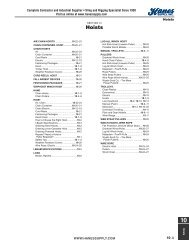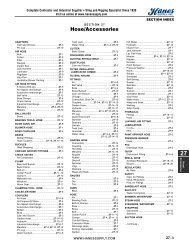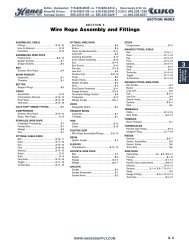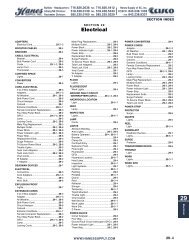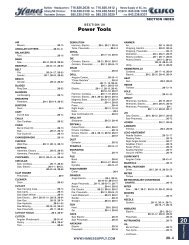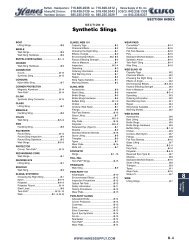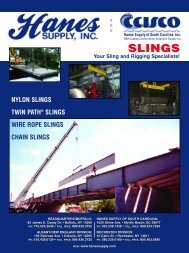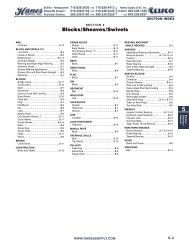twin-path® slings in action - Hanes Supply, Inc
twin-path® slings in action - Hanes Supply, Inc
twin-path® slings in action - Hanes Supply, Inc
- No tags were found...
Create successful ePaper yourself
Turn your PDF publications into a flip-book with our unique Google optimized e-Paper software.
YOUR SLING AND RIGGING SPECIALISTbasic lift eng<strong>in</strong>eer<strong>in</strong>geffect of anGlesVarious sl<strong>in</strong>g manufacturers refer <strong>in</strong> theirspecification tables to leg angles of <strong>sl<strong>in</strong>gs</strong>dur<strong>in</strong>g lifts – s<strong>in</strong>ce these angles have a directrelationship to lift<strong>in</strong>g capability of asl<strong>in</strong>g. Regardless of how the sl<strong>in</strong>g anglemay be stated, or the method used to computestress <strong>in</strong> a sl<strong>in</strong>g leg, the sl<strong>in</strong>g is thesame. Capacity does not change – butstresses on sl<strong>in</strong>g legs change with rigg<strong>in</strong>gangles.Much misunderstand<strong>in</strong>g results becausethe carry<strong>in</strong>g capacity of a sl<strong>in</strong>g leg is reducedby the rigg<strong>in</strong>g angle. What happensis that the operator is lift<strong>in</strong>g the loadstraight up (vertical) while the legs arepull<strong>in</strong>g at an angle, thereby caus<strong>in</strong>g a disadvantage.For quick figur<strong>in</strong>g <strong>in</strong> the shop, a 60-degreeleg angle causes a loss <strong>in</strong> lift<strong>in</strong>g capacityof 15%... a 45-degree angle reduces capacityby 30%... and a 30-degree angle,50%. This rule of thumb is not 100% accurate,but is easy to remember and slightlyon the safe side.It is always good practice, with<strong>in</strong> limits, tokeep the sl<strong>in</strong>g leg angle as large as possible.The length and width of the load sl<strong>in</strong>glength, and available headroom are determ<strong>in</strong><strong>in</strong>gfactors <strong>in</strong> this sl<strong>in</strong>g angle.It is neither economical nor good practice toexceed a 45-degree sl<strong>in</strong>g leg angle.Angles less than 45 degrees not only buildup tension <strong>in</strong> the sl<strong>in</strong>g legs out of all proportionto the weight of the load, they also createa much greater "<strong>in</strong>-pull" on the ends ofthe load. This produces eccentrically loadedcolumn effect, as an eng<strong>in</strong>eer would describeit – mean<strong>in</strong>g simply that long, slenderobjects have a tendency to buckle. Anglesless than 45 degrees <strong>in</strong>dicate some thoughtshould be given to the use of a lift<strong>in</strong>g beamor other device <strong>in</strong> connection with the lift.Study<strong>in</strong>g typical sl<strong>in</strong>g charts readily revealsthat lift<strong>in</strong>g capacities on <strong>sl<strong>in</strong>gs</strong> are mislead<strong>in</strong>gunless the sl<strong>in</strong>g angle is stated. Thesame sl<strong>in</strong>g that will handle 10 tons at an 85-degree leg angle will only handle 5 tons ifthis angle is decreased to 30 degrees.GooD slInG PRactIceRegardless of what type of sl<strong>in</strong>g may be employed,there are accepted good work<strong>in</strong>grules which will help <strong>in</strong>crease useful sl<strong>in</strong>g life– as well as improve safety. These <strong>in</strong>clude:1. Use the proper sl<strong>in</strong>g for the lift. WhetherTw<strong>in</strong>-Path, Web, Cha<strong>in</strong>, or Wire Rope, theproper sl<strong>in</strong>g is the one with the best comb<strong>in</strong>ationof work and handl<strong>in</strong>g feature – ofthe proper length and rated capacity forthe situation.2. Start and stop slowly. Crane hooksshould be raised slowly until the sl<strong>in</strong>g becomestaut and the load is suspended.Lift<strong>in</strong>g or lower<strong>in</strong>g speed should be <strong>in</strong>creasedor decreased gradually. Suddenstarts or stops place heavier loads on asl<strong>in</strong>g – comparable to jamm<strong>in</strong>g thebrakes on a speed<strong>in</strong>g automobile. A ruleof thumb: Shock loads can double thestress on a sl<strong>in</strong>g.3. If possible, set the load on blocks.Pull<strong>in</strong>g a sl<strong>in</strong>g from under a load causesabrasion and "curl<strong>in</strong>g" – mak<strong>in</strong>g the sl<strong>in</strong>gharder to handle on the next lift, while reduc<strong>in</strong>gstrength through loss of metal.4. Sharp corners cut <strong>sl<strong>in</strong>gs</strong>. Use protectorarcs, Cornermax and Synthetic ArmorWear Pads between sharp corners andthe sl<strong>in</strong>g body.5. Store <strong>in</strong> a dry room. Moisture is a naturalenemy of wire rope – as are acidfumes and other caustic gases.6. Avoid handl<strong>in</strong>g hot material or objects <strong>in</strong>direct contact with the sl<strong>in</strong>g. Strengthgoes down as temperature goes up!7. Dropp<strong>in</strong>g cast<strong>in</strong>g, tools or heavy objectson <strong>sl<strong>in</strong>gs</strong>, or runn<strong>in</strong>g over them withtrucks, can cause damage. Always hang<strong>sl<strong>in</strong>gs</strong> when not <strong>in</strong> use.8. Use hooks properly. "Po<strong>in</strong>t load<strong>in</strong>g" reduceshook capacity. Pull should bestraight <strong>in</strong> the l<strong>in</strong>e of lift.selectInG a slInGThe follow<strong>in</strong>g is presented as a guide onlyto help <strong>in</strong> selection of a sl<strong>in</strong>g for a lift.1. Determ<strong>in</strong>e the Load: The weight of theload must be known. This is always thestart<strong>in</strong>g po<strong>in</strong>t.2. Decide the Hitch: Shape and bulk of theload must be accommodated as well asweight. Determ<strong>in</strong>e whether a straight attachmentat some po<strong>in</strong>t on the load, achoker around the load, or some form ofbasket hitch will best control the loaddur<strong>in</strong>g the lift.3. Adequacy of Lift<strong>in</strong>g Device: The lift<strong>in</strong>gdevice must have adequate capacity formak<strong>in</strong>g the lift, and provide any maneuverabilityrequired once the load ishoisted.4. Room to Lift: Make certa<strong>in</strong> the lift<strong>in</strong>g devicehas sufficient headroom to raise theload to the height required. Headroomwill affect the length of sl<strong>in</strong>g.5. Length of Sl<strong>in</strong>g: By apply<strong>in</strong>g your decisionon the type of hitch to knowledge ofthe headroom offered by the lift<strong>in</strong>g device,the length of sl<strong>in</strong>g can be calculated.6. Use Rated Capacity Chart: Always double-checkthat the sl<strong>in</strong>g type and capacityyou choose, when rigged at the angle determ<strong>in</strong>edby the length of the sl<strong>in</strong>g, or thespecific type of hitch, will handle the load.Attach<strong>in</strong>g the sl<strong>in</strong>g and complet<strong>in</strong>g the liftshould be an orderly procedure without "surprises"when these steps have been followed.Two further precautions should benoted, however.First, plan to protect both load and sl<strong>in</strong>g fromdamage at sharp corners, etc. Cornermaxand Synthetic Armor Wear Pads should beprovided at the lift site. A protective padshould be used anytime a sl<strong>in</strong>g passesaround a sharp corner.Last – by no means unimportant by be<strong>in</strong>glast – every sl<strong>in</strong>g should be visually exam<strong>in</strong>edfrom end to end BEFORE EVERY LIFT.It must always be kept <strong>in</strong> m<strong>in</strong>d that the manufacturer'sRated Capacity applies only to anew sl<strong>in</strong>g <strong>in</strong> "unused" condition. A <strong>sl<strong>in</strong>gs</strong>hould be carefully exam<strong>in</strong>ed to determ<strong>in</strong>ethat it is <strong>in</strong> as nearly new condition as practicablebefore each lift.There are specific standards on the use andcare of <strong>sl<strong>in</strong>gs</strong> <strong>in</strong> <strong>in</strong>dustries such as shipp<strong>in</strong>gand construction, and these provide someguidance for sl<strong>in</strong>g <strong>in</strong>spectors. Consensusstandards published as ANSI B30.9 are particularlyhelpful.ANSI Standard B30.9 specifies that a wirerope sl<strong>in</strong>g should be removed form serviceany time any of the follow<strong>in</strong>g conditions aredetected:1. Ten randomly distributed broken wires <strong>in</strong>one rope lay, or five broken wires <strong>in</strong> onestrand <strong>in</strong> one rope lay.2. K<strong>in</strong>k<strong>in</strong>g, crush<strong>in</strong>g, bird cag<strong>in</strong>g or anyother damage result<strong>in</strong>g <strong>in</strong> distortion ofthe wire rope structure.3. Evidence of heat damage.4. End attachments that are cracked, deformed,or worn.5. Hooks that have been opened more than15% of the normal throat open<strong>in</strong>g measuredat the narrowest po<strong>in</strong>t, or twistedmore than 10 degrees from the plane ofthe unbent hook.6. Corrosion of the rope or end attachments.It is apparent from the forego<strong>in</strong>g that <strong>in</strong>spectionof a wire rope sl<strong>in</strong>g to meet theseremoval criteria requires more than a casualunderstand<strong>in</strong>g of wire rope design andmanufacture, and the responsibility fordaily <strong>in</strong>spections must be <strong>in</strong> the hands oftra<strong>in</strong>ed personnel.Most of the forego<strong>in</strong>g applies equally to anytype of sl<strong>in</strong>g and careful <strong>in</strong>spection by atra<strong>in</strong>ed <strong>in</strong>spector is necessary for safe sl<strong>in</strong>guse. If you require tra<strong>in</strong><strong>in</strong>g for any type ofsl<strong>in</strong>g <strong>in</strong>spection, contact <strong>Hanes</strong> <strong>Supply</strong> formore <strong>in</strong>formation.HEADQUARTERS: 55 James E. Casey Drive • Buffalo, NY 14206 PHONE: 716.826.2636 FAX: 716.826.4412 www.hanessupply.com150


